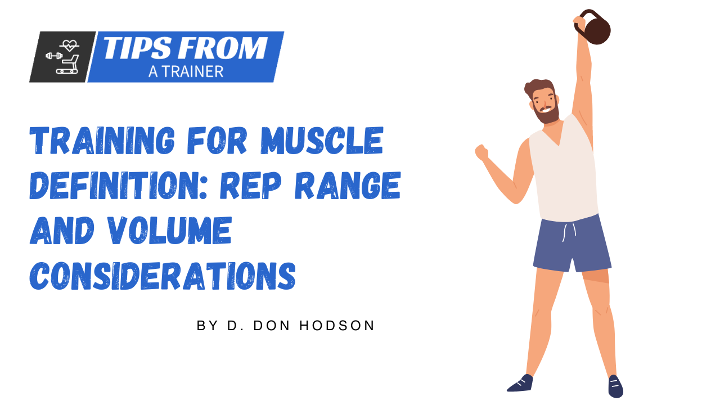Introduction
The Quest for Muscle Definition
In the realm of fitness aspirations, few goals stand as prominently as the pursuit of muscle definition. This aspiration transcends gender and age, captivating the attention of individuals who seek a sculpted physique that reflects their dedication to a healthy lifestyle. The allure of well-defined muscles is rooted in its association with strength, vitality, and a sense of accomplishment. Achieving muscle definition is not merely about aesthetics; it represents a tangible marker of the commitment to one's fitness journey.
The Role of Rep Range and Volume
Central to the attainment of muscle definition is a comprehensive understanding of the interplay between different training variables. Among these variables, two emerge as primary architects of muscle development: repetition range (rep range) and training volume. The selection of the appropriate rep range, coupled with an intelligent manipulation of training volume, forms the cornerstone of an effective strategy for sculpting muscles to chiseled perfection.
Purpose of the Article
Within the realm of fitness literature, this article seeks to be a guiding light, illuminating the intricate relationship between rep range and training volume in the context of muscle definition. The purpose of this article is to empower individuals with evidence-based insights that will inform their approach to training. By delving into the science behind muscle hypertrophy, analyzing the impact of varying rep ranges, and dissecting the critical concept of training volume, readers will be equipped to forge a path toward their muscle definition goals with precision and purpose.
Table of Contents
Introduction
The Quest for Muscle Definition
The Role of Rep Range and Volume
Purpose of the Article
Understanding Muscle Hypertrophy
Mechanisms of Muscle Growth
Hypertrophy vs. Strength Training
Importance of Progressive Overload
Rep Range and Its Impact on Muscle Definition
Low Reps (1-5): Strength vs. Definition
Moderate Reps (6-12): Finding the Balance
High Reps (13+): Endurance and Aesthetics
Volume: The Key Driver of Muscle Growth
Unveiling the Volume Concept
Volume Considerations for Muscle Definition
Balancing Volume and Recovery
Periodization Strategies for Muscle Definition
Linear Periodization
Undulating Periodization
Importance of De-load Phases
Nutrition's Role in Muscle Definition
Protein Intake for Muscle Recovery
Caloric Surplus vs. Deficit: Finding the Sweet Spot
Nutrient Timing and Muscle Glycogen
Rest and Recovery: Maximizing Muscle Definition
Sleep's Impact on Muscle Recovery
Active Recovery and Stretching
Stress Management and Its Effects
Conclusion
Crafting Your Muscle Definition Journey
Achieving Optimal Results: A Fusion of Science and Dedication

Understanding Muscle Hypertrophy
Mechanisms of Muscle Growth
The biological phenomenon underlying the development of muscle definition is known as muscle hypertrophy. At its core, muscle hypertrophy is a process characterized by the enlargement of muscle fibers in response to systematic and progressive resistance training. This enlargement occurs through a complex series of molecular and cellular events, prominently featuring the synthesis of new proteins within muscle cells. As these proteins accumulate, muscle fibers increase in size, resulting in the visible muscle definition that is sought after by fitness enthusiasts.
Hypertrophy vs. Strength Training
It is crucial to differentiate between training for muscle hypertrophy and training for maximal strength. While both objectives share common ground in resistance training, their distinct outcomes necessitate tailored approaches. Muscle hypertrophy training is characterized by a focus on volume and is optimized to stimulate the growth of muscle fibers. In contrast, maximal strength training involves lifting heavier weights for lower reps, primarily targeting the neurological adaptations that enhance force production. While both pathways offer unique benefits, muscle hypertrophy training is the driving force behind the visible muscle definition that is the focal point of this article.
Importance of Progressive Overload
A universal principle governing muscle hypertrophy training is the concept of progressive overload. At its essence, progressive overload involves systematically challenging muscles with increasing resistance over time. This challenge prompts muscle fibers to adapt by becoming larger and stronger. By gradually increasing the resistance—be it through additional weight, increased reps, or heightened intensity—trainees trigger a continuous cycle of muscle growth. Progressive overload is the scaffolding upon which muscle definition is built, demanding a structured approach that ensures consistent and targeted muscle stimulation.
Rep Range and Its Impact on Muscle Definition
Low Reps (1-5): Strength vs. Definition
When considering the rep range for muscle definition, the spectrum begins with low repetitions, typically ranging from 1 to 5 reps per set. This range is often associated with strength-focused training. It primarily stimulates the neuromuscular system, enhancing the body's capacity to generate force. While low-rep training contributes to the development of muscle mass, its primary emphasis is on the activation of high-threshold motor units and the enhancement of intramuscular coordination. Muscle definition is a byproduct of the muscle's size and leanness, and while low-rep training may contribute to a portion of muscle definition, its emphasis on strength gains differentiates it from other rep ranges.
Moderate Reps (6-12): Finding the Balance
The moderate repetition range, spanning from 6 to 12 reps, stands as the sweet spot for optimizing muscle definition. This range merges the benefits of both strength and hypertrophy training. Training within this range places a significant mechanical load on muscle fibers while also stimulating the metabolic stress necessary for muscle growth. Moderate-rep training elicits a balance between recruiting high-threshold motor units and promoting metabolic fatigue, thereby fostering a potent environment for muscle hypertrophy. It is within this zone that individuals striving for muscle definition often find their most effective training strategy.
High Reps (13+): Endurance and Aesthetics
The high-repetition range, encompassing 13 or more reps per set, delves into the realm of muscular endurance and aesthetic refinement. Training within this range targets a unique array of muscle fibers, particularly those with high oxidative capacity. While it may not be the primary driver of muscle growth, high-rep training contributes to overall muscle definition by enhancing muscular endurance, refining muscle shape, and promoting capillarization. The increased time under tension during high-rep sets stimulates blood flow and metabolic byproducts, contributing to muscle toning and vascularity, which are characteristic components of a well-defined physique.
Volume: The Key Driver of Muscle Growth
Unveiling the Volume Concept
Within the realm of resistance training, the concept of volume reigns supreme. Volume, often defined as the total amount of weight lifted across all sets in a workout, is a fundamental determinant of muscle growth. The formula for calculating volume involves multiplying the number of sets, reps, and weight lifted. This cumulative mechanical tension, created through volume, serves as the catalyst for muscle hypertrophy. In essence, higher training volume translates to a greater stimulus for muscle growth, making it a paramount factor in the pursuit of muscle definition.
Volume Considerations for Muscle Definition
The manipulation of training volume serves as a potent tool in the pursuit of muscle definition. For individuals targeting muscle definition, a balance must be struck between high training volume and adequate recovery. Progressive overload, a principle discussed in the earlier sections, should guide the gradual increase in training volume to stimulate ongoing muscle growth. However, excessive volume without sufficient recovery may lead to overtraining, undermining progress. Therefore, judiciously increasing volume over time while respecting recovery periods becomes the cornerstone of effective muscle definition training.
Balancing Volume and Recovery
The relationship between training volume and recovery is a delicate dance that shapes the outcome of muscle definition efforts. Optimal muscle growth occurs during periods of rest, allowing for the repair and regeneration of muscle tissue. Excessive volume, devoid of proper recovery, can lead to fatigue and potential injury. Adequate rest intervals between workouts, coupled with proper sleep, nutrition, and hydration, ensure that the body is well-prepared for subsequent training sessions. The principle of balancing volume and recovery fosters an environment where muscles are continually challenged and allowed to recuperate, laying the foundation for progressive muscle definition.
Periodization Strategies for Muscle Definition
Linear Periodization
Linear periodization stands as a traditional and systematic approach to structuring a training program for muscle definition. The underlying principle of linear periodization involves gradually increasing the training volume and intensity over time, typically in a linear fashion. This periodization model is often organized into distinct phases, with each phase focusing on a specific aspect of muscle development. During the initial phases, the emphasis may be on building strength through lower reps and higher weights. As the program progresses, the focus shifts towards hypertrophy with moderate rep ranges. Linear periodization offers a logical progression that aligns with the body's adaptation to training stimulus, making it a methodical choice for those seeking muscle definition.
Undulating Periodization
Undulating periodization, also known as nonlinear periodization, introduces a level of variability and flexibility into the training plan. This approach involves frequent changes in volume and intensity, providing a diverse stimulus for muscle growth. The undulating model incorporates high, moderate, and low rep ranges within the same week or training cycle. This strategy keeps the body continuously challenged and prevents adaptation plateaus. By integrating varying rep ranges, undulating periodization ensures a constant engagement of different muscle fibers and energy systems, contributing to enhanced muscle definition.
Importance of De-load Phases
De-load phases are strategically incorporated periods of reduced training intensity and volume within a training program. While de-loading may seem counterintuitive to muscle growth, it plays a crucial role in preventing overtraining and promoting long-term progress. De-load phases provide the body with the opportunity to recover, repair, and adapt to the accumulated training stress. During these phases, the focus shifts towards active recovery techniques, lower weights, and reduced training frequency. De-loads facilitate recovery and prepare the body for the upcoming phases of intense training, ultimately supporting the pursuit of muscle definition without compromising overall health.
Nutrition's Role in Muscle Definition
Protein Intake for Muscle Recovery
Protein, often referred to as the building block of muscle, plays an instrumental role in muscle definition. Adequate protein intake is essential to support muscle recovery and growth. During resistance training, muscle fibers experience microscopic damage that necessitates repair and rebuilding. Protein consumption provides the amino acids required for this repair process, promoting muscle protein synthesis and aiding in the development of lean muscle mass. For individuals seeking muscle definition, a balanced distribution of protein intake throughout the day is recommended, supporting continuous muscle repair and growth.
Caloric Surplus vs. Deficit: Finding the Sweet Spot
The relationship between caloric intake and muscle definition hinges on the delicate balance between energy consumption and expenditure. Achieving muscle definition requires shedding excess body fat to reveal well-defined muscles. This entails creating a caloric deficit, wherein the body expends more calories than it consumes. However, the caloric deficit must be managed carefully to avoid excessive muscle loss. Striking the optimal balance between caloric deficit and preservation of lean muscle mass is pivotal for successful muscle definition. Gradual and controlled reduction in caloric intake, coupled with appropriate macronutrient distribution, ensures that the body derives energy from stored fat while safeguarding muscle tissue.
Nutrient Timing and Muscle Glycogen
Nutrient timing, the strategic scheduling of meals and nutrients around training sessions, influences muscle glycogen storage and overall performance. Carbohydrates, a primary source of energy, are essential for maintaining high-intensity workouts that stimulate muscle definition. Consuming carbohydrates before and after workouts replenishes muscle glycogen stores, providing the energy necessary for optimal training performance. Moreover, post-workout carbohydrate intake supports the recovery process by initiating muscle glycogen restoration and enhancing protein synthesis. Proper nutrient timing contributes to sustained energy levels during workouts and supports the anabolic environment required for muscle definition.
With these insights into periodization strategies and the critical role of nutrition, individuals embarking on the journey of muscle definition can harness the power of science-backed methods to achieve their desired results.
Rest and Recovery: Maximizing Muscle Definition
Sleep's Impact on Muscle Recovery
Sleep, often overlooked in fitness discussions, plays a pivotal role in optimizing muscle definition. During sleep, the body undergoes critical physiological processes that contribute to muscle recovery and growth. Rapid eye movement (REM) and non-REM sleep phases facilitate protein synthesis, allowing damaged muscle fibers to repair and rebuild. Adequate sleep also promotes the release of growth hormone, a key factor in muscle development. Sleep deficiency disrupts these processes, hindering muscle recovery and potentially leading to muscle loss. Prioritizing sleep hygiene by ensuring a consistent sleep schedule and creating a conducive sleep environment can greatly enhance muscle definition efforts.
Active Recovery and Stretching
Active recovery techniques encompass low-intensity activities aimed at promoting blood flow and aiding muscle recovery. Engaging in light aerobic exercises, such as brisk walking or cycling, during rest days can alleviate muscle soreness and improve nutrient delivery to muscle tissues. Stretching, another vital aspect of active recovery, enhances muscle flexibility and joint range of motion. Incorporating dynamic and static stretching routines into the training regimen can prevent muscle imbalances, reduce the risk of injury, and contribute to the overall aesthetics of muscle definition.
Stress Management and Its Effects
The impact of stress on muscle definition extends beyond the gym. Chronic stress triggers the release of cortisol, a hormone that, in excess, can lead to muscle breakdown and hinder muscle growth. Stress management techniques, such as meditation, deep breathing, and mindfulness, mitigate cortisol levels and support an environment conducive to muscle development. Additionally, engaging in activities that promote relaxation, such as yoga or leisurely walks, contributes to overall stress reduction. By prioritizing stress management, individuals can safeguard their muscle definition journey and achieve optimal results.
Conclusion
Crafting Your Muscle Definition Journey
The pursuit of muscle definition requires a well-rounded approach that encompasses various factors, including training, nutrition, rest, and recovery. The integration of scientific principles into a tailored training program empowers individuals to craft a personalized muscle definition journey. By understanding the interplay between rep range, volume, periodization, nutrition, and recovery strategies, individuals can make informed decisions to optimize muscle growth and definition.
Achieving Optimal Results: A Fusion of Science and Dedication
The journey toward muscle definition is a fusion of science and dedication. Armed with knowledge about rep ranges, volume, periodization, nutrition, and recovery, individuals can embark on their transformational path. The key to achieving optimal results lies in the consistent application of evidence-based practices and a steadfast commitment to the goals. As you sculpt your physique and define your muscles, remember that success is a product of unwavering determination, scientific understanding, and a dedication to embracing a lifestyle that fosters muscle definition and overall well-being.

Don Hodson, Certified Personal Trainer
I'm Don, an ACE-certified personal trainer and the founder of Tips From A Trainer. With my passion for fitness and years of experience, I've helped countless individuals transform their physiques!
Having personally overcome weight challenges throughout my life, I understand the struggle. Through consistency, exercise, and a balanced diet, I have managed to stay in shape and I want to share my message with the world!
The fitness industry is fraught with misconceptions and deceptive practices, which is why I am committed to providing you with the truth.
- My Site: www.Don-Hodson.com
- My Company: www.ConnectedAgeMarketing.com

Training for Muscle Definition